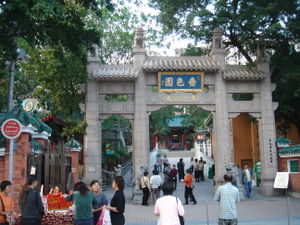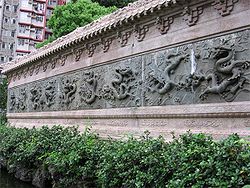
Wong Tai Sin Temple
Encyclopedia


Shrine
A shrine is a holy or sacred place, which is dedicated to a specific deity, ancestor, hero, martyr, saint, daemon or similar figure of awe and respect, at which they are venerated or worshipped. Shrines often contain idols, relics, or other such objects associated with the figure being venerated....
s in Hong Kong
Hong Kong
Hong Kong is one of two Special Administrative Regions of the People's Republic of China , the other being Macau. A city-state situated on China's south coast and enclosed by the Pearl River Delta and South China Sea, it is renowned for its expansive skyline and deep natural harbour...
. It is dedicated to Wong Tai Sin
Wong Tai Sin
Wong Tai Sin is a Chinese deity popular in Hong Kong with the power of healing. His name literally translates to the "Great Immortal Wong". Wong Tai Sin is the divine form of the individual "Wong Cho Ping".-Legend:...
, or the Great Immortal
Immortality
Immortality is the ability to live forever. It is unknown whether human physical immortality is an achievable condition. Biological forms have inherent limitations which may or may not be able to be overcome through medical interventions or engineering...
Wong. The 18,000-m² Taoist temple
Temple
A temple is a structure reserved for religious or spiritual activities, such as prayer and sacrifice, or analogous rites. A templum constituted a sacred precinct as defined by a priest, or augur. It has the same root as the word "template," a plan in preparation of the building that was marked out...
is famed for the many prayers answered: "What you request is what you get" (有求必應) via a practice called kau cim. The temple is located on the southern side of Lion Rock
Lion Rock
Lion Rock, or less formally Lion Rock Hill, is a famous hill in Hong Kong. It is located between Kowloon Tong in Kowloon and Tai Wai in the New Territories, and is 495 metres high...
in the north of Kowloon
Kowloon
Kowloon is an urban area in Hong Kong comprising the Kowloon Peninsula and New Kowloon. It is bordered by the Lei Yue Mun strait in the east, Mei Foo Sun Chuen and Stonecutter's Island in the west, Tate's Cairn and Lion Rock in the north, and Victoria Harbour in the south. It had a population of...
.
History
In the early 20th century, Leung Renyan (梁仁庵) spread the influence of Wong Tai Sin from Qiaoshan (樵山), GuangxiGuangxi
Guangxi, formerly romanized Kwangsi, is a province of southern China along its border with Vietnam. In 1958, it became the Guangxi Zhuang Autonomous Region of the People's Republic of China, a region with special privileges created specifically for the Zhuang people.Guangxi's location, in...
province of China
China
Chinese civilization may refer to:* China for more general discussion of the country.* Chinese culture* Greater China, the transnational community of ethnic Chinese.* History of China* Sinosphere, the area historically affected by Chinese culture...
to Wan Chai
Wan Chai
Wan Chai is a metropolitan area situated at the western part of the Wan Chai District on the northern shore of Hong Kong Island, in Hong Kong. Its other boundaries are Canal Road to the east, Arsenal Street to the west and Bowen Road to the south. The area north of Gloucester Road is often called...
, in Hong Kong. On the main altar of the temple stands the painting of the Taoist god, which was originally brought to Hong Kong from Guangdong province in 1915. In 1921, under the advice of an enlightened one, they moved the temple to Rosy Garden, its current position.
The temple remained a private shrine limited to only "Pu Yi Tan" Taoists and their family members until 1934, when the government opened the temple to the public during Chinese New Year
Chinese New Year
Chinese New Year – often called Chinese Lunar New Year although it actually is lunisolar – is the most important of the traditional Chinese holidays. It is an all East and South-East-Asia celebration...
. Temple historians often describe the shrine as a miraculous structure for surviving the Japanese occupation
Japanese occupation of Hong Kong
The Japanese occupation of Hong Kong began after the Governor of Hong Kong, Sir Mark Young, surrendered the territory of Hong Kong to Japan on 25 December 1941 after 18 days of fierce fighting by British and Canadian defenders against overwhelming Japanese Imperial forces. The occupation lasted...
in the 1940s relatively unscathed.
In 1956, the government proposed to reclaim the temple for public housing development. Chairman Wong Wan Tin's pushed for the temple to remain open. Charging a 10-cent admission fee at the main entrance, fees were donated to the Tung Wah Group of Hospitals
Tung Wah Group of Hospitals
The Tung Wah Group of Hospitals , with a long history from 1870, is the oldest and the largest charitable organisation in Hong Kong. Their education Services and Community Services to the community with a total of 194 service centres spreading over the territory of Hong Kong.Although it appears a...
. To facilitate administration and management, the temple was registered as a limited company of charitable nature in 1965, and was granted the immunity of not having to add the word "Limited" to the organization's name.
Because of its historic significance, the Temple is graded as a Grade II historic building.
Facilities

Nine-Dragon Wall
A Nine-Dragon Wall or Nine-Dragon Screen is a type of screen wall with reliefs of nine different Chinese dragons...
modeled after one in Beijing
Beijing
Beijing , also known as Peking , is the capital of the People's Republic of China and one of the most populous cities in the world, with a population of 19,612,368 as of 2010. The city is the country's political, cultural, and educational center, and home to the headquarters for most of China's...
. The Three-Saint Hall (三聖堂) is dedicated to Lü Dongbin
Lü Dongbin
Lǚ Dòngbīn is a historical figure and also a deity/Immortal revered by many in the Chinese culture sphere, especially by Daoists/Taoists. Lǚ Dòngbīn is one of the most widely known of the group of deities known as the Eight Immortals and considered by some to be the de facto leader...
, Guan Yin, and Lord Guan. Containing a portrait of Confucius
Confucius
Confucius , literally "Master Kong", was a Chinese thinker and social philosopher of the Spring and Autumn Period....
, the Taoist temple has a collection of Confucian, Taoist, and Buddhist literature.
The architecture is the traditional Chinese temple style with grand red pillars, a magnificent golden roof adorned with blue friezes, yellow latticework, and multi-colored carvings. Aside from the Daxiong-baodian or Grand Hall, Sansheng Hall and the Good Wish Garden are also worth seeing. The temple grounds also feature three memorial archways. The first one stands outside the temple and is carved with the name of the temple. If you walk past the soothsayers and the fortune-telling stalls, you can see another memorial archway. And if you continue further along the third memorial archway standing before you. .
Traditions

Lunar month
In lunar calendars, a lunar month is the time between two identical syzygies . There are many variations. In Middle-Eastern and European traditions, the month starts when the young crescent moon becomes first visible at evening after conjunction with the Sun one or two days before that evening...
, and the Chinese New Year
Chinese New Year
Chinese New Year – often called Chinese Lunar New Year although it actually is lunisolar – is the most important of the traditional Chinese holidays. It is an all East and South-East-Asia celebration...
holidays are the busiest times for the temple.
On the Chinese New Year's Eve, thousands of worshippers wait outside the temple before midnight and rush in to the main altar to offer Wong Tai Sin
Wong Tai Sin
Wong Tai Sin is a Chinese deity popular in Hong Kong with the power of healing. His name literally translates to the "Great Immortal Wong". Wong Tai Sin is the divine form of the individual "Wong Cho Ping".-Legend:...
their glowing incense sticks
Incense
Incense is composed of aromatic biotic materials, which release fragrant smoke when burned. The term "incense" refers to the substance itself, rather than to the odor that it produces. It is used in religious ceremonies, ritual purification, aromatherapy, meditation, for creating a mood, and for...
when the year comes. As the tradition goes, the earlier they offer the incense, the better luck they will have that year.
Most of the visitors come to the temple in search for a spiritual answer via a practice called kau cim. They light incense sticks, kneel before the main altar, make a wish, and shake a bamboo
Bamboo
Bamboo is a group of perennial evergreens in the true grass family Poaceae, subfamily Bambusoideae, tribe Bambuseae. Giant bamboos are the largest members of the grass family....
cylinder containing fortune sticks until a stick falls out. This stick is exchanged for a piece of paper bearing the same number, and then the soothsayer
Fortune-telling
Fortune-telling is the practice of predicting information about a person's life. The scope of fortune-telling is in principle identical with the practice of divination...
will interpret the fortune on the paper for the worshiper. Often the same piece of fortune is taken to multiple booths for verification purposes. Some booths offer palm reading
Chiromancy
Palmistry or chiromancy , is the art of characterization and foretelling the future through the study of the palm, also known as palm reading, or chirology. The practice is found all over the world, with numerous cultural variations...
service.
Recently, Taoist wedding
Wedding
A wedding is the ceremony in which two people are united in marriage or a similar institution. Wedding traditions and customs vary greatly between cultures, ethnic groups, religions, countries, and social classes...
s have been performed here.
Operation
The temple is open from 7:00am to 5:30pm throughout the year, and runs overnight in the Lunar New Year Eve. It is currently administrated by Sik Sik Yuen, a Taoist organization in Hong Kong.See also
- Places of worship in Hong KongPlaces of worship in Hong KongHong Kong counts approximately 600 temples, shrines and monasteries. While Buddhism and Taoism are the most widely practiced religions, most religions are represented in the Special Administrative Region.-Buddhist temples and monasteries:...
- List of buildings and structures in Hong Kong

